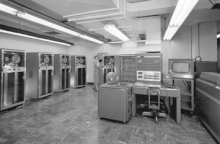Mainframe
A mainframe ( Engl. Mainframe computer ) or a mainframe computer is a complex and comprehensive computer system that goes far beyond the capabilities of a computer staff and usually also on the typical server systems beyond.
Typical areas of application are the highly reliable processing of mass data (e.g. customer data from insurance companies), mass transaction systems (e.g. flight booking systems , ATM systems ) or business-critical data (e.g. ERP systems). Mainframes differ from supercomputers ( high-performance computers ) in terms of their tasks and areas of application and, as a result, their construction. They are optimized for the quasi-simultaneous processing of a large number of similar, simple data processing operations, such as flight bookings, than for the quick calculation of a scientific or technical task such as a supercomputer.
Mainframes are increasingly coming to the fore again in the context of server consolidation measures and cloud computing .


properties
Coordinated, robust and highly redundant components are built into a mainframe . These computers are usually maintained during operation, and hardware replacement and upgrades do not impair or even interrupt operations.
A mainframe is primarily characterized by its reliability and high input-output performance. It can serve a large number of users in online operation ( time sharing ), but also perform complicated and time-consuming tasks in batch operation. When operating online, users have access to a mainframe computer via computer terminals . Since personal computers (PCs) became popular, such terminals have mostly been replaced by corresponding emulations on the PCs.
scope of application
In contrast to supercomputers , which are developed for high computing power , mainframe computers are designed for reliability and high data throughput. Mainframe computers are typically used in banks, insurance companies, large companies and in public administration. A relatively new area of application for mainframes is the consolidation of server farms . With a mainframe and an appropriate operating system, it is possible to start many virtual servers . This saves space and electricity and simplifies administration.
For many tasks where increased reliability is required, but a mainframe computer is oversized or technically unsuitable, so-called medium data technology is also used, for example based on OS / 400 , VMS , UNIX and, increasingly, Linux .
history
Tube computers represented the first generation and mainly solved military tasks. With the invention of the transistor in the mid-1950s, the following mainframe computers initially found their way into research institutions, for example to solve differential equations . There they usually took up an entire room to themselves, which had to be air-conditioned to counteract the heat development of the devices.
In terms of personnel, a distinction was made between programmers and operators . The latter operated the computer system: They fed the punch card readers , fetched the required magnetic tapes according to the instructions of the console printer / telex printer and inserted them and brought them back later, fed the printer and tape punch with paper and removed the media produced. That could occupy several people at the same time.
This mode of operation was known as batch or batch processing. The workflows at that time were, for example, as follows:
An operator brought arithmetic tasks punched onto punched cards to a separate device, which read the punched cards and saved the data on a magnetic tape. Another operator brought this magnetic tape to the actual mainframe computer, which processed the magnetic tape and saved the output on another magnetic tape. Another operator brought the magnetic tape with the results to a printer, which transferred the data from the magnetic tape to paper.
In the mid-1960s, so-called multiprogramming ( multi-program operation ) was introduced. It had been found that the CPU itself was not used for a large part of the time, as it had to wait for the input and output operations of the tapes until it could process its next job. Therefore, the main memory was divided into sub-areas and so several tapes could be processed simultaneously.
At the time, most computer manufacturers had developed two systems:
- Word-oriented mainframe computers for the technical and scientific field
- Character-oriented mainframe computers for the commercial sector
IBM was the first manufacturer to combine both application areas in the OS / 360 operating system .
For some years now, manufacturers such as Sun or Hewlett-Packard (with the “Superdome”) have been trying to be successful in the mainframe market segment with special UNIX- based systems .
Mainframes have also been used in online games since 2007. The main focus here is on the very high data throughput of the mainframe computers - the computing power required to generate the game flow is provided by dedicated servers. The resulting combination is also known as a gameframe .
Operating systems used
The main operating system used on mainframes includes z / OS (including USS ), z / VM , z / VSE , Unicos , OS / 360 , OS / 390 , BS2000 , NOS , NOS / BE, Multics , KRONOS , Linux , MVS , Scope , TPF , UNIVAC 1100/2200 , CMS or GCOS are used.
Manufacturer
|
|
See also
- Central Electronic Complex
- Job transfer and manipulation
- Miniaturization
- Mini computer
- Universal computer
Web links
- Stefan Betschon: Dancing Dinosaurs - IBM breathes new life into the mainframe , in: Neue Zürcher Zeitung No. 173 of July 29, 2010, p. 50
- RadioTux broadcast about the history of the mainframe and how Linux came to the mainframe
Individual evidence
- ↑ IBM combines mainframe and cell processor for "Gameframe" at COMPUTERWOCHE on April 27, 2007

